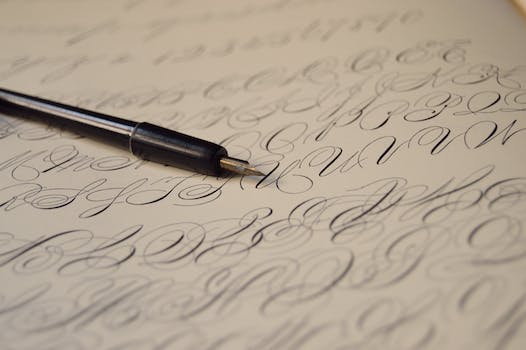-
Table of Contents
- The Art of Calligraphy Writing A to Z
- The History of Calligraphy
- Key Takeaways:
- Calligraphy Techniques
- Key Takeaways:
- Calligraphy Tools
- Key Takeaways:
- Calligraphy Tips for Beginners
- Key Takeaways:
- Summary
- Q&A
- 1. What is the best way to practice calligraphy?
- 2. What are the essential tools for calligraphy writing?
- 3. How can I find my unique calligraphy style?
- 4. What are some common mistakes to avoid in calligraphy writing?
- 5. How can I take my calligraphy skills to the next level?

Calligraphy is a beautiful and ancient art form that has been practiced for centuries. From elegant scripts to modern styles, calligraphy encompasses a wide range of writing techniques that can be used to create stunning works of art. In this comprehensive guide, we will explore the basics of calligraphy writing from A to Z, including its history, techniques, tools, and tips for beginners.
The History of Calligraphy
Calligraphy has a rich history that dates back to ancient civilizations such as the Egyptians, Greeks, and Romans. These early cultures used calligraphy to inscribe important documents, religious texts, and artistic works. In the Middle Ages, calligraphy flourished in Europe with the development of Gothic and Carolingian scripts. During the Renaissance, calligraphy became an essential skill for scribes and artists alike.
Key Takeaways:
- Calligraphy has been practiced for centuries by various cultures around the world.
- It has evolved over time with different scripts and styles emerging in different periods.
- Calligraphy was an important skill for scribes and artists throughout history.
Calligraphy Techniques
There are several key techniques that are essential for mastering calligraphy. These include proper posture, hand positioning, pen grip, and stroke formation. Different scripts require different techniques, so it is important to practice regularly and experiment with various styles to find what works best for you.
Key Takeaways:
- Proper posture and hand positioning are crucial for successful calligraphy writing.
- Experimenting with different scripts and styles can help you find your unique calligraphy voice.
- Regular practice is essential for mastering calligraphy techniques.
Calligraphy Tools
Calligraphy requires specific tools to achieve the desired results. The most important tool is the calligraphy pen, which comes in various sizes and styles. Other essential tools include ink, paper, rulers, and guidelines. Investing in high-quality tools can make a significant difference in the quality of your calligraphy work.
Key Takeaways:
- The calligraphy pen is the most important tool for calligraphy writing.
- High-quality tools can improve the overall look and feel of your calligraphy work.
- Experimenting with different tools can help you find what works best for you.
Calligraphy Tips for Beginners
For beginners, getting started with calligraphy can be intimidating. However, with the right guidance and practice, anyone can learn this beautiful art form. Here are some tips to help you get started:
Key Takeaways:
- Start with the basics and practice regularly to improve your skills.
- Experiment with different scripts and styles to find what works best for you.
- Don’t be afraid to make mistakes – they are part of the learning process.
Summary
Calligraphy is a timeless art form that requires patience, practice, and dedication to master. By understanding the history, techniques, tools, and tips for beginners, you can embark on a journey to explore the beauty of calligraphy writing from A to Z. Whether you are a seasoned calligrapher or a beginner looking to learn a new skill, calligraphy offers a creative outlet that can be both rewarding and fulfilling.
Q&A
1. What is the best way to practice calligraphy?
Regular practice is key to improving your calligraphy skills. Set aside time each day to practice different scripts and styles to find what works best for you.
2. What are the essential tools for calligraphy writing?
The most important tool for calligraphy writing is the calligraphy pen. Other essential tools include ink, paper, rulers, and guidelines.
3. How can I find my unique calligraphy style?
Experimenting with different scripts and styles can help you find your unique calligraphy voice. Don’t be afraid to try new techniques and explore different artistic influences.
4. What are some common mistakes to avoid in calligraphy writing?
Common mistakes in calligraphy writing include inconsistent spacing, shaky lines, and smudged ink. Practice proper technique and take your time to avoid these errors.
5. How can I take my calligraphy skills to the next level?
To take your calligraphy skills to the next level, consider taking classes or workshops, studying the work of master calligraphers, and experimenting with advanced techniques and styles.






